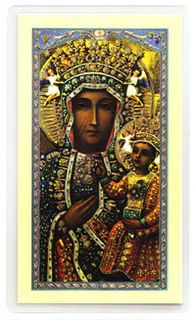
Black_madonna

For those who hooked like me to CNN during the wake of Pope JPII, you might have noticed that beside the large cross at the altar where he was being viewed, there was a tiny icon of Our Lady right beside it. That is the Black Madonna from the Jasna Gora Monastery in Czechostowa, Poland.
She is the Patron Saint of the Pope. I was able to visit the place twice with my parents.
There are two version of the history of the Jasna Gora painting. There is a traditional version, steeped in legend and an historical one, reconstructed by art critics whose attention was drawn to this extraordinary image and its origins.
According to the traditional version, the painting was created by St. Luke the Evangelist on a table top from the house of the Holy Family. St. Luke was said to have painted two images of Mary, one of which found its way to Italy and was kept in Bologna where it is still venerated. The other was said to have been removed from Jerusalem and brought to Constantinopole by the Emperor Constantine and placed in a church. Six centuries later, the Russian Prince Lev obtained the painting from the emperor of the time in acknowledgement of his military achievements.
During the wars in Rus, Prince Ladislaus of Opole found the painting in the castle at Bełz and discovered it was being venerated as if it were miraculous. After the victory over the Tatars, he brought the painting to Czestochowa, entrusting it to Pauline Monks for safekeeping. This information is contained in a manuscript - one of the oldest - entitled "Translatio Tabulae", a copy of which, dated 1474, is conserved in the Jasna Góra archives.
According to art critics, the Jasna Góra painting was originally a Byzantine icon (of the Hodigitria type), dating between the sixth and ninth centuries.
The Miraculous presence of the image has always attracted pilgrims not only from all over Poland but from all over the world, as the numerous votive offerings show. It was painted on a wood panel measuring 122.2 x 82.2 x 3.5 cms. and features a bust of the Virgin with Jesus in her arms. Mary's face dominates the painting and observers find themselves immersed in her eyes. They look at Mary, who looks back at them.
The face of the Child is also turned towards the pilgrim but his eyes are looking elsewhere. The two faces have a serious and thoughtful expression adding to the emotional tone of the painting. Our Lady's right cheek is marked by two parallel slashes and a third horizontal cut. The neck of the image is marred with six scratches, two more visible than others. Jesus, dressed in a scarlet tunic is supported by His Mother's left hand, his right hand is raised in a magisterial gesture, of sovereignty and benediction. The hand of the Virgin rests on Her breast, as if she were indicating the Child. The Virgin's robe and mantle are decorated with lilies, the symbol of the Hungarian royal family. A six-pointed star is featured on Mary's brow. An important element are the auras around the Virgin and Child since their luminous quality contrasts with the dark facial tones.













No comments:
Post a Comment